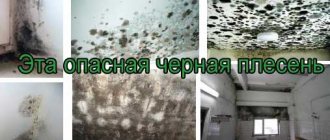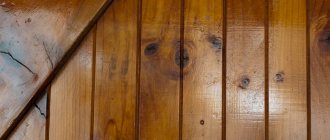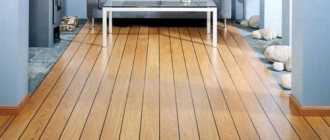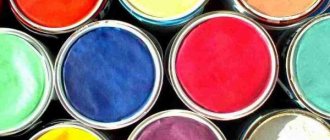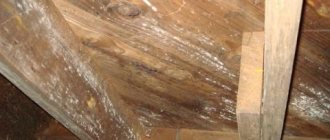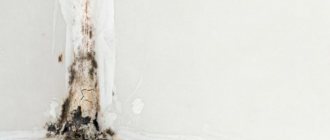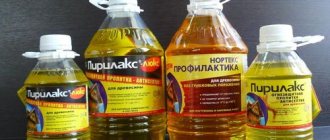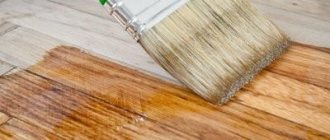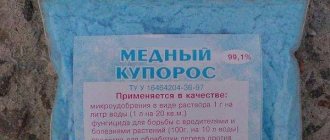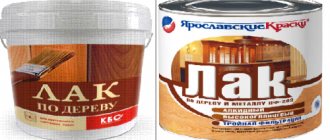The advantages of wooden buildings, interior and exterior finishes are overshadowed by the high probability of biological deterioration of the material.
Effective treatment of wood against fungus and mold can instill confidence in the reliability and safety of the structure. There are a large number of improvised and industrial means that can protect wooden buildings from the proliferation of microorganisms.
Reasons for appearance
In natural conditions, trees, thanks to their immunity, successfully protect themselves from the active spread of biopollutants. Subsequently, the natural resistance of the wood declines, so it needs to be treated.
Additional infection can occur due to improper storage and operation of structures. The following factors contribute to the appearance of mold on wood:
- high humidity;
- temperature changes over a wide range of values;
- ineffective ventilation;
- freezing of the material;
- poor waterproofing of the building;
- high groundwater level.
Fungi can be brought into the room on shoes or clothes, so when entering, you should follow basic sanitary rules. Often the source of microbes is drywall, in which they multiply easily and quickly. In wet places, you need to install only special plasterboard sheets that are suitable for use in such conditions.
If the negative effects of the environment are completely eliminated or at least significantly reduced, fungal infections of wood can be completely avoided, freeing yourself from the need for treatment.
How to treat wood and boards against rotting?
Rotting, which is caused by the activity of biological organisms, brings little joy to the owner, but nothing can be done about it. Everyone has the power to make sure that this moment comes as late as possible. To do this, you need to know about factors that can accelerate the decay process:
- high air humidity;
- high humidity of feedstock;
- lack of good ventilation;
- temperature changes;
- condensation accumulation;
- freezing of the material;
- regular interaction with moist soil.
The best protection of wood from rotting can be ensured if all necessary measures are taken at the stage of its harvesting and storage. The main measures to protect wooden elements from rotting are aimed at increasing resistance to moisture, which can penetrate the pores of the material. To do this, it is necessary to carry out high-quality waterproofing , as well as paint, which can protect wooden structures from moisture contained in the atmosphere. The above operations can be supplemented by installing high-quality thermal insulation and a vapor barrier ceiling to reduce the negative impact of condensation.
An effective recommendation from experts is to place wooden building structures at a height above ground level. It is also necessary to cover the ends of the log house walls with boards and apply special protective compounds to them.
Types of mold
There are several types of microorganisms and fungi that most often settle on wood. They differ in external characteristics, reproduction rate, toxicity of released products, and degree of deterioration of the material.
Note! It is easier to prevent the appearance of fungus by pre-treating with antiseptic impregnations or primers, paints with protective properties.
The most dangerous and aggressive type of mold is black mold, all strains of which multiply quickly, severely destroy wood, and can cause illness in humans. It is the most difficult to remove.
White types of mold can appear not only on wooden products, but also on food and various products. These fungi are removed faster and easier; they are less dangerous, although they can also cause irritation and allergies.
There are bluish types of mold that actively destroy wooden materials. They are especially dangerous for load-bearing structures, where they cause through-rotting. To remove them, the wooden surface must be cleaned mechanically and bleaches must be used.
Actinomycetes, bacteria similar in structure and properties to fungi, significantly worsen the performance characteristics of wood. When infected by these microorganisms, which appear primarily in places of high humidity, the softening of the material occurs very quickly. Infestation should be removed with strong antiseptics.
Fire retardant wood treatment
One of the main disadvantages that wood has is its high flammability. But special products available for sale today make it possible to nullify the manifestation of this disadvantage. It is advisable to use them simultaneously with antiseptic drugs. For the most effective application, it is recommended to carry out treatment with impregnating agents under certain conditions:
- Low wood moisture content (up to 25%);
- Impregnation temperature is about 60-85 ° C;
- Applying impregnation to specially made tattoos.
To treat wooden elements for fire protection, you can use the following preparations:
- Senezh OGNEBIO;
- Neomid 450;
- Pirilax;
- Valti Pohusti.
For the best effect, the above preparations must be applied in several layers.
Folk remedies
Wood has been used by humans for several millennia, which has led to the accumulation of many simple methods to combat biological deterioration. Folk remedies can be prepared in ordinary home conditions without large financial costs.
The most popular are the following compounds that can remove mold or prevent its occurrence:
- resins (bituminous or based on turpentine and rosin) and oils (waste, drying oil);
- ordinary silicate glue;
- technical chromium (potassium dichromate or dichromate);
- aqueous solution of copper sulfate;
- technical soda;
- diluted bleach solution.
Each wood treatment product has its positive and negative sides.
Resins and oils
Before processing, the resin must be warmed well and brought to a homogeneous viscous state. Then the warm mass should be evenly distributed on the wood. The coating is suitable for treating the lower part of buildings in contact with the ground; it is used in sheds, cellars, and on the basement of bathhouses.
Bitumen resin cannot be called environmentally friendly. Recently, it is rarely used, but bitumen mastics are produced on its basis. They are excellent waterproofers, protecting wood from the formation of fungus and mold.
Wood resins (with rosin) are used mainly for processing small wood products. When there were no synthetic materials yet, tar was widely used, but it has a strong specific odor, just like bitumen.
One of the most common means for treating wood against mold and subsequent rotting is oil extraction. The treatment coats boards that support parts of wood structures. Used oil takes a long time to dry, causes odor, harmful fumes, hides the texture of the wood, but perfectly protects against pests and allows you to effectively fight mold. Instead, you can treat the wood with boiled linseed, sunflower or other oil or drying oil (the same oil with additives).
Silicates
You can get rid of mold on wooden objects if the material is slightly damaged by microorganisms with an aqueous solution of silicates, such as ordinary glue or liquid glass. The product is harmless, easy to apply, but does not have a very long-lasting effect. It is very likely that wood processing in this way will have to be repeated often.
Potassium dichromate
Potassium bichromate, which can be bought in gardening stores, has a powerful destructive effect on mold and fungi.
Crystals in the proportion specified in the instructions are dissolved in a dilute aqueous solution of sulfuric acid, and then applied to the walls and floors of the log house. If the product is prepared correctly, the effect will be immediate; the mold will be destroyed and discolored almost instantly.
It should be remembered that the substance has a strong oxidizing effect on all material objects, including the skin of the hands and mucous membranes of the eyes. Chrompic solution should not be allowed to come into contact with humans; for this purpose, treatment against fungi and mold must be carried out while observing safety precautions.
Soda
Much less dangerous is ordinary soda, which copes especially well with local contamination at the initial stage. As soon as the first signs of wood infection appear, you need to sprinkle soda powder on the boards or logs and pour vinegar over it. As a result of the chemical reaction, microorganisms will immediately disappear provided they penetrate shallowly into the material.
Copper sulfate
An aqueous solution of copper sulfate, which can also be easily purchased in stores for summer residents, is highly effective against fungi. Almost colorless powder in an amount of 100 g should be dissolved in a bucket of water, after which the finished bluish solution should be treated with timber, boards, and any other wood materials.
Bleaching
Fungi are quite successfully destroyed when treated with bleach. The result will be visible immediately, however, you need to be prepared for the wood to lighten a little. Bleach is a well-known bleach that destroys not only dirt, but also coloring pigments. Work with bleach must be carried out carefully, wearing gloves and protective clothing. If the treatment is carried out in an enclosed space, for example in a basement, you need to ensure good air exchange and install fans.
Prevention methods
If the cause of fungal development is not eliminated, the situation may recur after treatment. To protect wood from infection, take the following actions:
- in case of dampness in basements and attics, check the condition of the foundation and roof, improve waterproofing;
- fungi do not tolerate sunlight, it is important to ensure the penetration of UV rays;
- improve air circulation in the room, use fans if necessary;
- the room in which mold forms is dried, air heaters can be used;
- avoid temperature changes.
To prevent the development of mold, a wooden house must be heated in winter. It is important to monitor the condition of the basement and cellar, since these rooms are most susceptible to infection. In apartment buildings, mold can grow in bathrooms and wood paneling.
Once every 3-5 years, it is recommended to re-treat the wood with mold and mildew agents. Even with effective antiseptic compounds, it is easier to prevent the development of fungus than to completely eliminate it.
When building a wooden house, it is important to immediately cut through the openings for air circulation and to prevent dampness.
Special compositions against fungi
In case of severe damage to wood, ordinary folk remedies may not help; you will have to resort to the help of professionally made preparations, which are supplied to the market in sufficient quantities by industrial enterprises.
The drug “Senezh” has a universal effect, which removes fungi, microbes, spores and even insects. Before application, the wood surface must be well prepared, especially areas affected by black mold. This may require removing the top layer with a grinder, stiff brush or knife.
Note! All affected shavings should be carefully burned so that bio-dirt particles do not spread into the surrounding space.
It is advisable to wash the cleaned wood well and dry it naturally, then process it. The preparation is firmly fixed to wood and is suitable for treating any external surface.
Neomid 430 is highly effective, successfully destroying fungi, moss, and microbes. The composition is non-toxic and is well absorbed by the soil without causing damage to it. The substance protects the wood from moisture and allows subsequent coating with varnishes or paints.
The Vinha product creates a polymer film and is recommended for treating external surfaces. The composition slightly changes the color of the wooden material and is convenient for application to previously treated surfaces. The drug protects against biological organisms, mechanical influences, and moisture vapor.
“Pinotex” has multifunctional properties, which is easily absorbed by the wood base, while performing priming. The treatment is applied to the outer parts of clean, prepared wood, which is subsequently treated with varnish.
Paint and varnish compositions have a protective effect, which should be applied to a cleaned, disinfected base. Many types of products prevent destruction not only from microorganisms, but also from sunlight, moisture, and dust.
The main brands of solutions on the market and their features
Choosing a high-quality antiseptic for wood against fungus is very important, since the quality of protection and durability of the coating largely depends on this. It is impossible to determine the characteristics of a particular composition by color, smell or consistency, so we will look at the products of several manufacturers that have proven themselves in the market; these are the ones you need to focus on:
| Biosept | One of the most famous and popular options, and for good reason - this antifungal product for wood is made on the basis of new generation biocides, which makes the composition safe for the environment, very durable and weather-resistant. In addition, the treated surface can be painted with any paint, which is also important. |
| Aquatex | This composition is ideal for processing various carpentry products - from furniture to doors and windows, as well as other planed surfaces. Its main advantage is its low price; one can also note its good absorption even into hard wood. |
| Pinotex | Another well-known brand that produces a wide range of protective products: these can be colorless solutions, as well as matte and glossy compositions of various shades, as well as paints that completely cover the structure of the wood. The protective layer is very durable; the shelf life can range from 5 to 30 years, depending on operating conditions. |
| Biox | The main advantage of this group of products is the highlighting of the wood structure, which is very much appreciated in cases where it is necessary to present products in the most advantageous color. The compositions can be either transparent or with different shades. |
| Elkon | This manufacturer produces several lines of impregnating agents: for freshly cut wood, for the ends of structures, for baths and saunas, and so on. This allows you to choose the best option for any features of the object. |
| Tikkurila | This Finnish manufacturer is well known for the good quality of paints and varnishes; the impregnations are not inferior in quality and are available in different versions for different types of surfaces. |
Important! This is not a complete list of possible options; in fact, there are many more. We have touched only on those that are most often found on store shelves and enjoy deserved popularity among customers.
The glazing antiseptic EcoWood from Tikkurila is popular among professionals
We recommend: 4 ways to assemble a homemade sandblasting machine with your own hands
